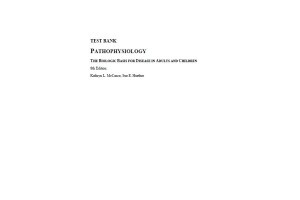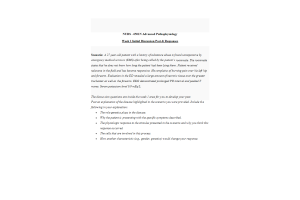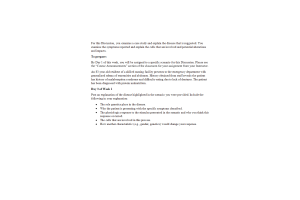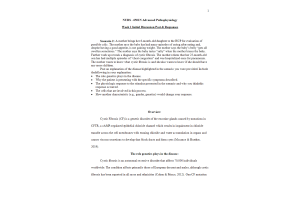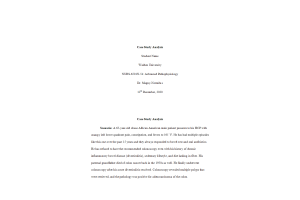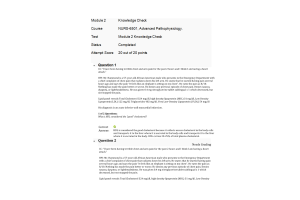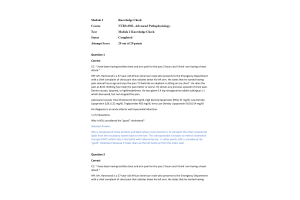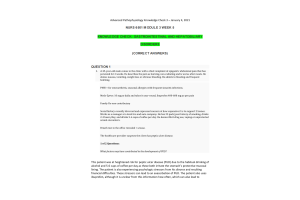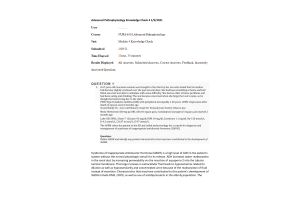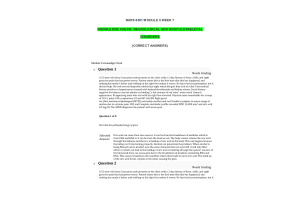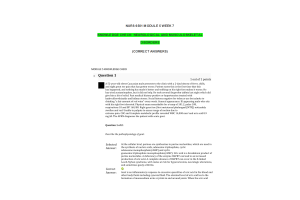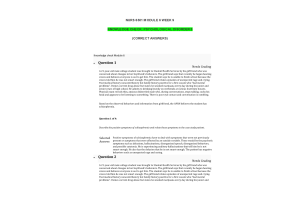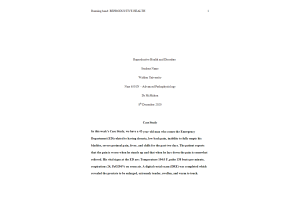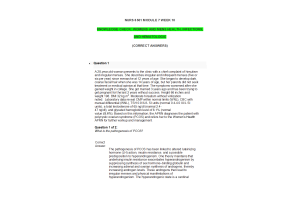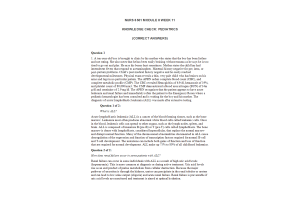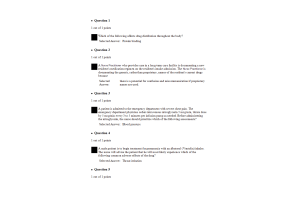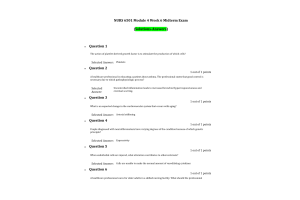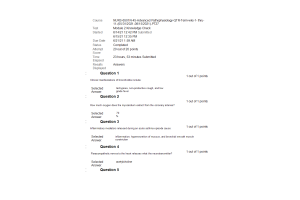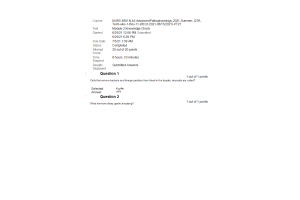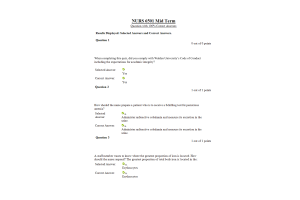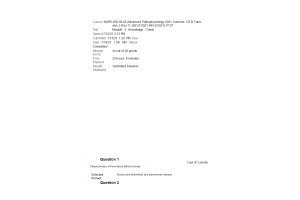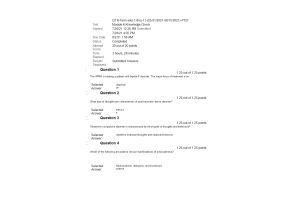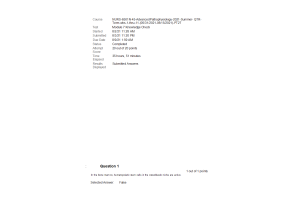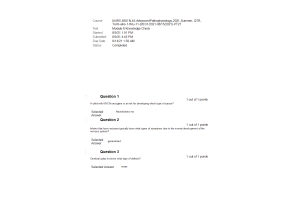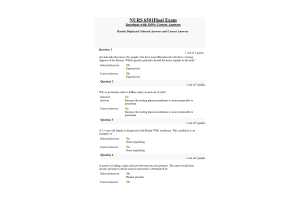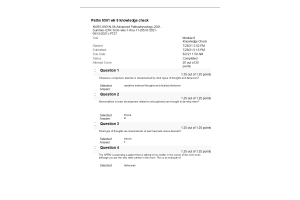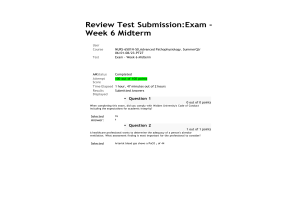NURS 6501 Week 11 Knowledge Check; Pediatrics
- $25.00
- Question: A ten-year-old boy is brought to clinic by his mother who states that the boy has been listless and not eating. She also notes that he has been easily bruising without trauma as he says he is too tired to go out and play. He says his bones hurt sometimes. Mother states the child has had intermittent fevers that respond to acetaminophen. Maternal history negative for pre, intra, or post-partum problems. Child’s past medical history negative and he easily reached developmental milestones. Physical exam reveals a thin, very pale child who has bruises on his arms and legs in no particular pattern. The APRN orders complete blood count (CBC), and complete metabolic profile (CMP). The CBC revealed Hemoglobin of 6.9/dl, hematocrit of 19%, and platelet count of 80,000/mm3. The CMP demonstrated a blood urea nitrogen (BUN) of 34m g/dl and creatinine of 2.9 mg/dl. The APRN recognizes that the patient appears to have acute leukemia and renal failure and immediately refers the patient to the Emergency Room where a pediatric hematologist has been consulted and is waiting for the boy and his mother. The diagnosis of acute lymphoblastic leukemia (ALL) was made after extensive testing.
Question 1 of 2: What is ALL?
- Question: A ten-year-old boy is brought to clinic by his mother who states that the boy has been listless and not eating. She also notes that he has been easily bruising without trauma as he says he is too tired to go out and play. He says his bones hurt sometimes. Mother states the child has had intermittent fevers that respond to acetaminophen. Maternal history negative for pre, intra, or post-partum problems. Child’s past medical history negative and he easily reached developmental milestones. Physical exam reveals a thin, very pale child who has bruises on his arms and legs in no particular pattern. The APRN orders complete blood count (CBC), and complete metabolic profile (CMP). The CBC revealed Hemoglobin of 6.9/dl, hematocrit of 19%, and platelet count of 80,000/mm3. The CMP demonstrated a blood urea nitrogen (BUN) of 34m g/dl and creatinine of 2.9 mg/dl. The APRN recognizes that the patient appears to have acute leukemia and renal failure and immediately refers the patient to the Emergency Room where a pediatric hematologist has been consulted and is waiting for the boy and his mother. The diagnosis of acute lymphoblastic leukemia (ALL) was made after extensive testing.
Question 2 of 2: How does renal failure occur in some patients with ALL?
- Question: A 12-year-old female with known sickle cell disease (SCD) present to the Emergency Room in sickle cell crisis. The patient is crying with pain and states this is the third acute episode she has had in the last nine months. Both parents are present and appear very anxious and teary eyed. A diagnosis of acute sickle cell crisis was made. Appropriate therapeutic interventions were initiated by the APRN and the patient’s pain level decreased, and she was transferred to the pediatric intensive care unit (PICU) for observation and further management.
Question 1 of 2: What is the pathophysiology of acute SCD crisis and why is pain the predominate feature of acute crises?
- Question: A 12-year-old female with known sickle cell disease (SCD) present to the Emergency Room in sickle cell crisis. The patient is crying with pain and states this is the third acute episode she has had in the last nine months. Both parents are present and appear very anxious and teary eyed. A diagnosis of acute sickle cell crisis was made. Appropriate therapeutic interventions were initiated by the APRN and the patient’s pain level decreased, and she was transferred to the pediatric intensive care unit (PICU) for observation and further management.
Question 2 of 2: Discuss the genetic basis for SCD.
- Question: The parents of a 9-month boy bring the infant to the pediatrician’s office for evaluation of a swollen right knee and excessive bruising. The parents have noticed that the baby began having bruising about a month ago but thought the bruising was due to the child’s attempts to crawl. They became concerned when the baby woke up with a swollen knee. Infant up to date on all immunizations, has not had any medical problems since birth and has met all developmental milestones. Pre-natal, intra-natal, and post-natal history of mother noncontributory. Family history negative for any history of bleeding disorders or other major genetic diseases. Physical exam within normal limits except for obvious bruising on the extremities and right knee. Knee is swollen but no warmth appreciated. Range of motion of knee limited due to the swelling. The pediatrician suspects the child has hemophilia and orders a full bleeding panel workup which confirms the diagnosis of hemophilia A.
Question 1 of 2: Explain the genetics of hemophilia.
- Question: The parents of a 9-month boy bring the infant to the pediatrician’s office for evaluation of a swollen right knee and excessive bruising. The parents have noticed that the baby began having bruising about a month ago but thought the bruising was due to the child’s attempts to crawl. They became concerned when the baby woke up with a swollen knee. Infant up to date on all immunizations, has not had any medical problems since birth and has met all developmental milestones. Pre-natal, intra-natal, and post-natal history of mother noncontributory. Family history negative for any history of bleeding disorders or other major genetic diseases. Physical exam within normal limits except for obvious bruising on the extremities and right knee. Knee is swollen but no warmth appreciated. Range of motion of knee limited due to the swelling. The pediatrician suspects the child has hemophilia and orders a full bleeding panel workup which confirms the diagnosis of hemophilia A.
Question 2 of 2: Briefly describe the pathophysiology of Hemophilia.
- Question: During a routine 16-week pre-natal ultrasound, spina bifida with myelomeningocele was detected in the fetus. The parents continued the pregnancy and labor was induced at 38 weeks with the birth of a female infant with an obvious defect at Lumbar Level 2. The Apgar Score was 7 and 9. The infant was otherwise healthy. The sac was leaking cerebral spinal fluid and the child was immediately taken to the operating room for coverage of the open sac. The infant remained in the neonatal intensive care unit (NICU) for several weeks then discharged home with the parents after a prescribed treatment plan was developed and the parents were educated on how to care for this infant.
Question 1 of 2: What is the underlying pathophysiology of myelomeningocele?
- Question: During a routine 16-week pre-natal ultrasound, spina bifida with myelomeningocele was detected in the fetus. The parents continued the pregnancy and labor was induced at 38 weeks with the birth of a female infant with an obvious defect at Lumbar Level 2. The Apgar Score was 7 and 9. The infant was otherwise healthy. The sac was leaking cerebral spinal fluid and the child was immediately taken to the operating room for coverage of the open sac. The infant remained in the neonatal intensive care unit (NICU) for several weeks then discharged home with the parents after a prescribed treatment plan was developed and the parents were educated on how to care for this infant.
Question 2 of 2: Describe the pathophysiology of hydrocephalus in infants with myelomeningocele.
- Question: A preterm infant was delivered at 32 weeks gestation and was taken to the NICU for critical care management. Physical assessment of the chest and heart remarkable for a continuous-machinery type murmur best heard at the left upper sternal border through systole and diastole. The infant had bounding pulses, an active precordium, and a palpable thrill. The infant was diagnosed with a patent ductus arteriosus (PDA).
Question: Discuss the hemodynamic consequences of a PDA.
- Question: A 7-year-old male was referred to the school psychologist for disruptive behavior in the classroom. The parents told the psychologist that the boy has been difficult to manage at home as well. His scholastic work has gotten worse over the last 6 months and he is not meeting educational benchmarks. His parents are also worried that he isn’t growing like the other kids in the neighborhood. He has been bullied by other children which is contributing to his behaviors. The psychologist suggests that the parents have some blood work done to check for any abnormalities. The complete blood count (CBC) revealed a hypochromic microcytic anemia. Further testing revealed the child had a venous lead level of 21 mcg/dl (normal is < 10 mcg/dl). The child was diagnosed with lead poisoning and it was discovered he lived in public housing that had not finished stripping lead paint from the walls and woodwork.
Question: How does lead poisoning account for the child’s symptoms?
- Question: Emergency Medical Services (EMS) was dispatched to a home to evaluate the report of an unresponsive 3-month-old infant. Upon arrival, the EMS found a frantic attempt by the presumed father to resuscitate an infant. The EMS took over and attempted CPR but was unable to restore pulse or respiration. The infant was transported to the Emergency Room where the physician pronounced the child dead of Sudden Infant Death Syndrome (SIDS). The distraught parents were questioned as to the events surrounding the discovery of the baby. Parents state the child was in good health, had taken a full 6-ounce bottle of formula prior to being put down for the evening. The child had been sleeping through the night prior to this. Parents stated the baby had had some “sniffles” a few days before and was taken to the pediatrician who diagnosed the child with a mild upper respiratory tract viral syndrome. No other pertinent history.
Question: What is thought to be the underlying pathophysiology of SIDS?
- Question: A 4-year-old female is brought to the pediatrician by her mother who states the child has been running a fever to 102.0 F, has “pink eye”, and that her tongue looks very bright red and swollen. The mother states the fever has been present for 5 days, noticed the child had developed a rash and that the child’s legs look “puffy”. No other symptoms noted. Past medical history noncontributory. All immunizations up to date. Physical exam remarkable for current fever of 102.8 F, bilateral conjunctivitis without purulent material, oral mucosa with bright red erythema, dry, with fissuring of the lips. Legs noted to have peripheral edema and are also erythematous. Palmar desquamation noted. There is fine maculopapular rash and + cervical adenopathy. The presumptive diagnosis currently (pending laboratory data) is Kawasaki Disease.
Question 1 of 2: What is Kawasaki Disease and what is the pathophysiology?
- Question: A 4-year-old female is brought to the pediatrician by her mother who states the child has been running a fever to 102.0 F, has “pink eye”, and that her tongue looks very bright red and swollen. The mother states the fever has been present for 5 days, noticed the child had developed a rash and that the child’s legs look “puffy”. No other symptoms noted. Past medical history noncontributory. All immunizations up to date. Physical exam remarkable for current fever of 102.8 F, bilateral conjunctivitis without purulent material, oral mucosa with bright red erythema, dry, with fissuring of the lips. Legs noted to have peripheral edema and are also erythematous. Palmar desquamation noted. There is fine maculopapular rash and + cervical adenopathy. The presumptive diagnosis currently (pending laboratory data) is Kawasaki Disease.
Question 2 of 2: How does Kawasaki Disease cause coronary aneurysms?
- Question: A 9-year-old boy was brought to the Urgent Care Center by his parents who state that the child had a sudden onset of difficulty catching his breath, has a new cough and is making a “funny sound” when he breathes. The parents state there is no prior history of this, and the child had not been ill prior to the start of the symptoms. Past medical history noncontributory. No family history of respiratory problems. No known allergies to drugs or food. Physical exam positive for respiratory rate of 26, use of accessory muscles, with suprasternal retractions, heart rate of 132 beats per minute, an audible inspiratory and expiratory wheeze noted, and the pulse oximetry is 89% on room air. After the APRN institutes appropriate urgent treatment, the child’s breathing slowly returned to normal, vital signs normalize, and the pulse oximetry increases to 97%. The APRN suspects the child has asthma and tells the parents that they need to bring the child to a pulmonologist for further evaluation and care.
Question: What is the underlying pathophysiology of asthma?
- Question: A 24-year-old female with known cystic fibrosis (CF) has been admitted to the hospital for evaluation for possible lung transplant. She was diagnosed with CF when she was 9 months old and has had multiple hospitalizations for pneumonia, respiratory failure, and small bowel obstructions. She currently is oxygen dependent and has been told by her physicians that she has end stage pulmonary disease secondary to CF. The only recourse for her currently is lung transplant.
Question 1 of 2: What is cystic fibrosis and discuss the pathophysiology.
- Question: A 24-year-old female with known cystic fibrosis (CF) has been admitted to the hospital for evaluation for possible lung transplant. She was diagnosed with CF when she was 9 months old and has had multiple hospitalizations for pneumonia, respiratory failure, and small bowel obstructions. She currently is oxygen dependent and has been told by her physicians that she has end stage pulmonary disease secondary to CF. The only recourse for her currently is lung transplant.
Question 2 of 2: What is the reason people with CF are often malnourished?
- Question: A 14-year old girl who was trying out for cheerleading underwent a physical examination by the APRN who notices that the girl had uneven hip height, asymmetry of the shoulder height, shoulder and scapular prominence and rib prominence. The rest of the physical exam was normal and the APRN referred the girl to an orthopaedist for evaluation for possible scoliosis. Radiographs in the orthopaedic office confirms the diagnosis of idiopathic scoliosis. The spinal curve was measured at 26 degrees and it was recommended that the girl be fit for a low-profile back brace.
Question: What is thought to be the pathophysiology of idiopathic scoliosis?
- Question: A 2-year-old boy was brought to Urgent Care by his parents who state the boy has been having large amounts of diarrhea, been very irritable and very pale. The parents noticed there was blood in the diarrhea and when the boy’s legs became swollen, they sought care. Past medical history noncontributory and all immunizations up to date. Social history noncontributory and the child is in day care 5 days a week. No known exposure to other sick children and the only new event the parents could think of is the day care workers took the children to a local petting zoo about a week ago. Physical exam revealed a pale, ill appearing child with swollen legs, tender abdomen, and petechia on the legs and abdomen. The APRN suspects the child may have been exposed to a bacterium at the petting zoo and arranges for the patient to be transferred to the Emergency Room. There the child was found to be in renal failure, have hypertension and was diagnosed with hemolytic uremic syndrome (HUS).
Question: What is the pathophysiology of HUS?
- Question: The parents of a 3-year-old boy bring the child to the pediatrician with concerns that their child seems “small for his age”. The parents state that the boy has always been small but did not worry until the child went to day care and they noticed other children of the same age were much bigger. They also note that his teeth were very late in coming in. Normal prenatal, perinatal and postnatal history and no medical history on either side of family regarding issues with growth and development. Physical exam is normal except for short limbs and small teeth. The pediatrician suspects the child has pituitary dwarfism. A complete laboratory and radiographic work up confirmed the diagnosis.
Question: What is the pathophysiology of pituitary dwarfism?
- Question: A 4-year-old boy was brought to the Emergency Room by his parents with a suspected femur fracture. The parents state the child was playing on the couch when he rolled off and cried out in pain. There were no other injuries noted. Review of the child’s chart revealed this was the 4th Emergency Room visit in the last 15 months for fractures after low impact injury. The parents were suspected of child abuse and Child and Protective Services were consulted. The APRN assessing the child noted that the child had unusually thin and translucent skin, poor dentition, and blue sclera. The APRN suspects the child may have osteogenesis imperfecta (OI). Laboratory results revealed an elevated serum alkaline phosphatase and the diagnosis OI was made based on the clinical picture and elevated alkaline phosphatase.
Question: What is the pathophysiology of OI?

